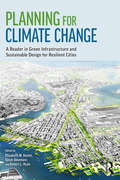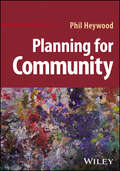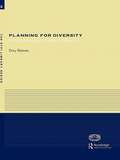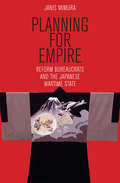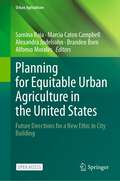- Table View
- List View
Planning for Agricultural Development (Routledge Library Editions: Agribusiness and Land Use #18)
by J. A. MollettOriginally published in 1984, this text was written as a guide to agricultural policy makers, planners and project managers in developing countries, particularly for those in the areas of programme formulation and implementation. Elements from successful agricultural and rural development plans have been selected. The work discusses the link between agricultural and overall planning, the various aspects of agricultural planning (including the usual components and deficiencies of plans, time horizons and scope of plans, and regional planning), and it concludes with brief look at the preparation of a plan and objectives for agricultural development.
Planning for Cities in Crisis: Lessons from Gondar, Ethiopia (Local and Urban Governance)
by Mulatu WubnehThis book analyzes ancient cities that are facing crisis, and their coping mechanism to maintain resiliency and sustainability to remain economically viable and historically relevant. The book takes a fresh look at the underlying causes of the crises and recommends good governance and strategic planning options that the city could use to develop a robust economy using surveys and other materials, including geez (old Ethiopian language) church sources. This book illustrates the usage of the concepts of resilience and sustainability to critically assess the historical and cultural transformation of cities and the role of local government in maintaining a sustainable community. A historic city that served as the national capital for close to 250 years, where Christians, Moslems, and Jews lived side by side for centuries, and once dubbed “Paris de l’Abyssinie” by European travelers because of its rich cultural resources, modern artifacts, and setting of new fashions, today Gondar is experiencing stagnation and decline because of changes that moved the center of political power from the city to Addis Ababa in the central part of the country. Since the last century, Gondar has been struggling to maintain its identity as the historical and cultural center of Ethiopia. This book also gives insights on some of Gondar’s extraordinary historic issues/subjects including who were the main construction workers that built the Fasil castle, how did the Ethiopian Orthodox churches of Gondar sustain themselves for centuries, where is kurate Reesu (the 16th century painting of Christ with crown of thorns) treasured by Gondarian emperors, how did the tabot of Abune Teklehaymanot of Debre Libanos (the most influential church in Ethiopia) end up in Azezo (Gondar) and stayed there for over 260 years, and who were the main royal women that opposed the Jesuits plan of converting Ethiopia to Catholicism?
Planning for Climate Change: Strategies for Mitigation and Adaptation for Spatial Planners
by Simin Davoudi Jenny Crawford Abid MehmoodClimate change is changing the context of spatial planning and shaping its priorities. It has strengthened its environmental dimension and has become a new rationale for coordinating actions and integrating different policy priorities. This book sets out the economic, social and environmental challenges that climate change raises for urban and regional planners and explores current and potential responses. These are set within the context of recent research and scholarly works on the role of spatial planning in combating climate change. Addressing both mitigation measures for reducing greenhouse gas emissions and adaptation to the effects of climate change, the book provides an overview of emerging practice, with analysis of the drivers of policy change and practical implementation of measures. It scopes planning issues and opportunities at different spatial scales, drawing on both the UK and international experiences and highlighting the need to link global and local responses to shared risks and opportunities.
Planning for Climate Change: Strategies for Mitigation and Adaptation for Spatial Planners
by Edited by Simin Davoudi Jenny Crawford Abid MehmoodClimate change is changing the context of spatial planning and shaping its priorities. It has strengthened its environmental dimension and has become a new rationale for coordinating actions and integrating different policy priorities. This book sets out the economic, social and environmental challenges that climate change raises for urban and regional planners and explores current and potential responses. These are set within the context of recent research and scholarly works on the role of spatial planning in combating climate change. Addressing both mitigation measures for reducing greenhouse gas emissions and adaptation to the effects of climate change, the book provides an overview of emerging practice, with analysis of the drivers of policy change and practical implementation of measures. It scopes planning issues and opportunities at different spatial scales, drawing on both the UK and international experiences and highlighting the need to link global and local responses to shared risks and opportunities.
Planning for Climate Change: A Reader in Green Infrastructure and Sustainable Design for Resilient Cities
by Elisabeth M. Hamin Infield Yaser Abunnasr Robert L. RyanThis book provides an overview of the large and interdisciplinary literature on the substance and process of urban climate change planning and design, using the most important articles from the last 15 years to engage readers in understanding problems and finding solutions to this increasingly critical issue. The Reader’s particular focus is how the impacts of climate change can be addressed in urban and suburban environments—what actions can be taken, as well as the need for and the process of climate planning. Both reducing greenhouse gas emissions as well as adapting to future climate are explored. Many of the emerging best practices in this field involve improving the green infrastructure of the city and region—providing better on-site stormwater management, more urban greening to address excess heat, zoning for regional patterns of open space and public transportation corridors, and similar actions. These actions may also improve current public health and livability in cities, bringing benefits now and into the future. This Reader is innovative in bringing climate adaptation and green infrastructure together, encouraging a more hopeful perspective on the great challenge of climate change by exploring both the problems of climate change and local solutions.
Planning for Climate Change: A Reader in Green Infrastructure and Sustainable Design for Resilient Cities
by Elisabeth M. Hamin Infield Yaser Abunnasr Robert L. RyanThis book provides an overview of the large and interdisciplinary literature on the substance and process of urban climate change planning and design, using the most important articles from the last 15 years to engage readers in understanding problems and finding solutions to this increasingly critical issue. The Reader’s particular focus is how the impacts of climate change can be addressed in urban and suburban environments—what actions can be taken, as well as the need for and the process of climate planning. Both reducing greenhouse gas emissions as well as adapting to future climate are explored. Many of the emerging best practices in this field involve improving the green infrastructure of the city and region—providing better on-site stormwater management, more urban greening to address excess heat, zoning for regional patterns of open space and public transportation corridors, and similar actions. These actions may also improve current public health and livability in cities, bringing benefits now and into the future. This Reader is innovative in bringing climate adaptation and green infrastructure together, encouraging a more hopeful perspective on the great challenge of climate change by exploring both the problems of climate change and local solutions.
Planning for Coexistence?: Recognizing Indigenous rights through land-use planning in Canada and Australia
by Libby Porter Janice BarryPlanning is becoming one of the key battlegrounds for Indigenous people to negotiate meaningful articulation of their sovereign territorial and political rights, reigniting the essential tension that lies at the heart of Indigenous-settler relations. But what actually happens in the planning contact zone - when Indigenous demands for recognition of coexisting political authority over territory intersect with environmental and urban land-use planning systems in settler-colonial states? This book answers that question through a critical examination of planning contact zones in two settler-colonial states: Victoria, Australia and British Columbia, Canada. Comparing the experiences of four Indigenous communities who are challenging and renegotiating land-use planning in these places, the book breaks new ground in our understanding of contemporary Indigenous land justice politics. It is the first study to grapple with what it means for planning to engage with Indigenous peoples in major cities, and the first of its kind to compare the underlying conditions that produce very different outcomes in urban and non-urban planning contexts. In doing so, the book exposes the costs and limits of the liberal mode of recognition as it comes to be articulated through planning, challenging the received wisdom that participation and consultation can solve conflicts of sovereignty. This book lays the theoretical, methodological and practical groundwork for imagining what planning for coexistence might look like: a relational, decolonizing planning praxis where self-determining Indigenous peoples invite settler-colonial states to their planning table on their terms.
Planning for Coexistence?: Recognizing Indigenous rights through land-use planning in Canada and Australia
by Libby Porter Janice BarryPlanning is becoming one of the key battlegrounds for Indigenous people to negotiate meaningful articulation of their sovereign territorial and political rights, reigniting the essential tension that lies at the heart of Indigenous-settler relations. But what actually happens in the planning contact zone - when Indigenous demands for recognition of coexisting political authority over territory intersect with environmental and urban land-use planning systems in settler-colonial states? This book answers that question through a critical examination of planning contact zones in two settler-colonial states: Victoria, Australia and British Columbia, Canada. Comparing the experiences of four Indigenous communities who are challenging and renegotiating land-use planning in these places, the book breaks new ground in our understanding of contemporary Indigenous land justice politics. It is the first study to grapple with what it means for planning to engage with Indigenous peoples in major cities, and the first of its kind to compare the underlying conditions that produce very different outcomes in urban and non-urban planning contexts. In doing so, the book exposes the costs and limits of the liberal mode of recognition as it comes to be articulated through planning, challenging the received wisdom that participation and consultation can solve conflicts of sovereignty. This book lays the theoretical, methodological and practical groundwork for imagining what planning for coexistence might look like: a relational, decolonizing planning praxis where self-determining Indigenous peoples invite settler-colonial states to their planning table on their terms.
Planning for Community
by Phil HeywoodPlanning for Community A comprehensive exploration of community planning that integrates today’s social and economic issues with policy and governance considerations In Planning for Community, distinguished regional and local planner Phil Heywood delivers an insightful examination of the accelerating impacts of social, environmental, and economic changes on community life and organization. He explores the ways in which these changes can be anticipated, planned for, and managed as he reviews and evaluates the nature and challenges of place and interaction faced by traditional and emerging local communities. The book includes discussions of the values, aims, and methods of community planning and the key operations in each of the fields of housing, work, transport, health, and environment. It should also inspire and assist readers to become more involved and influential in the lives of their local and wider communities. Readers will also find: A thorough introduction to methods of inclusion and empowerment enabling effective community management Comprehensive explorations of the ways the values of prosperity, liberty, social justice, and sustainability link to practical community problem-solving Practical discussions of the values, methods, activities, design, and governance shaping community planning Comprehensive, well-grounded, and effective treatments of policy development and practice Planning for Community is an excellent resource for professionals, activists, academics, and students seeking a comprehensive and readable guide to community planning.
Planning for Community
by Phil HeywoodPlanning for Community A comprehensive exploration of community planning that integrates today’s social and economic issues with policy and governance considerations In Planning for Community, distinguished regional and local planner Phil Heywood delivers an insightful examination of the accelerating impacts of social, environmental, and economic changes on community life and organization. He explores the ways in which these changes can be anticipated, planned for, and managed as he reviews and evaluates the nature and challenges of place and interaction faced by traditional and emerging local communities. The book includes discussions of the values, aims, and methods of community planning and the key operations in each of the fields of housing, work, transport, health, and environment. It should also inspire and assist readers to become more involved and influential in the lives of their local and wider communities. Readers will also find: A thorough introduction to methods of inclusion and empowerment enabling effective community management Comprehensive explorations of the ways the values of prosperity, liberty, social justice, and sustainability link to practical community problem-solving Practical discussions of the values, methods, activities, design, and governance shaping community planning Comprehensive, well-grounded, and effective treatments of policy development and practice Planning for Community is an excellent resource for professionals, activists, academics, and students seeking a comprehensive and readable guide to community planning.
Planning for Community Resilience: A Handbook for Reducing Vulnerability to Disasters
by Jaimie Hicks MastersonHow can we plan and design stronger communities? From New Orleans to Galveston to the Jersey Shore, communities struck by natural disasters struggle to recover long after the first responders have left. Globally, the average annual number of natural disasters has more than doubled since 1980. These catastrophes are increasing in number as well as in magnitude, causing greater damage as we experience rising sea levels and other effects of climate change. Communities can reduce their vulnerability to disaster by becoming more resilient—to not only bounce back more readily from disasters but to grow stronger, more socially cohesive, and more environmentally responsible. To be truly resilient, disaster preparation and recovery must consider all populations in the community. By bringing together natural hazards planning and community planning to consider vulnerabilities, more resilient and equitable communities are achievable. In Planning for Community Resilience the authors describe an inclusive process for creating disaster-resilient communities. This handbook guides any community through the process of determining their level of hazard exposure, physical vulnerability, and social vulnerability with the goal of determining the best planning strategy. This will be an invaluable tool for professionals working to protect their community from disturbance.
Planning for Diversity: Policy and Planning in a World of Difference (RTPI Library Series #Vol. 8)
by Dory ReevesThe practical importance of diversity and equality for spatial planning and sustainable development is still not widely understood. Using international examples, this book shows planners and educationalists the benefits of building in a consideration of diversity and equality at each stage and level of planning.Despite being one of the most diverse and gender balanced of the built environment professions, complacency has been widespread in planning. This book shows why a diverse profession is important and drawing on a wide range of good practice, shows how those involved in planning can develop their sensitivity to and expertise in diversity and equality.
Planning for Diversity: Policy and Planning in a World of Difference (RTPI Library Series)
by Dory ReevesThe practical importance of diversity and equality for spatial planning and sustainable development is still not widely understood. Using international examples, this book shows planners and educationalists the benefits of building in a consideration of diversity and equality at each stage and level of planning.Despite being one of the most diverse and gender balanced of the built environment professions, complacency has been widespread in planning. This book shows why a diverse profession is important and drawing on a wide range of good practice, shows how those involved in planning can develop their sensitivity to and expertise in diversity and equality.
Planning For Drought: Toward A Reduction Of Societal Vulnerability
by Donald Wilhite William Easterling Deborah A. Wood Eugene RasmussonDroughts and their management are a serious challenge to water resource professionals. While droughts predominate in arid regions, their frequency and severity in more temperate regions with more abundant rainfall have been on the rise. Drought Management and Planning for Water Resources provides an essential collection of planning and management t
Planning For Drought: Toward A Reduction Of Societal Vulnerability
by Donald Wilhite William Easterling Deborah A. Wood Eugene RasmussonDroughts and their management are a serious challenge to water resource professionals. While droughts predominate in arid regions, their frequency and severity in more temperate regions with more abundant rainfall have been on the rise. Drought Management and Planning for Water Resources provides an essential collection of planning and management t
Planning for Ecosystem Services in Cities (SpringerBriefs in Environmental Science)
by Davide Geneletti Chiara Cortinovis Linda Zardo Blal Adem EsmailThis open access book presents current knowledge about ecosystem services (ES) in urban planning, and discusses various urban ES topics such as spatial distribution of urban ecosystems, population distribution, and physical infrastructure properties. The book addresses all these issues by: i) investigating to what extent ecosystem services are currently included in urban plans, and discussing what is still needed to improve planning practice; ii) illustrating how to develop ecosystem services indicators and information that can be used by urban planners to enhance plan design; iii) demonstrating the application of ES assessments to support urban planning processes through case studies; and iv) reflecting on criteria for addressing equity in urban planning through ecosystem service assessments, by exploring issues associated with the supply of, the access to and demand for ES by citizens. Through fully worked out case studies, from policy questions, to baseline analysis and indicators, and from option comparison to proposed solutions, the book offers readers detailed and accessible coverage of outstanding issues and proposed solutions to better integrate ES in city planning. The overall purpose of the book is to provide a compact reference that can be used by researchers as a key resource offering an updated perspective and overview on the field, as well as by practitioners and planners/decision makers as a source of inspiration for their activity. Additionally, the book will be a suitable resource for both undergraduate and post-graduate courses in planning and geography.
Planning for Empire: Reform Bureaucrats and the Japanese Wartime State (Studies of the Weatherhead East Asian Institute, Columbia University)
by Janis MimuraJapan’s invasion of Manchuria in September of 1931 initiated a new phase of brutal occupation and warfare in Asia and the Pacific. It forwarded the project of remaking the Japanese state along technocratic and fascistic lines and creating a self-sufficient Asian bloc centered on Japan and its puppet state of Manchukuo. In Planning for Empire, Janis Mimura traces the origins and evolution of this new order and the ideas and policies of its chief architects, the reform bureaucrats. The reform bureaucrats pursued a radical, authoritarian vision of modern Japan in which public and private spheres were fused, ownership and control of capital were separated, and society was ruled by technocrats.Mimura shifts our attention away from reactionary young officers to state planners—reform bureaucrats, total war officers, new zaibatsu leaders, economists, political scientists, engineers, and labor party leaders. She shows how empire building and war mobilization raised the stature and influence of these middle-class professionals by calling forth new government planning agencies, research bureaus, and think tanks to draft Five Year industrial plans, rationalize industry, mobilize the masses, streamline the bureaucracy, and manage big business. Deftly examining the political battles and compromises of Japanese technocrats in their bid for political power and Asian hegemony, Planning for Empire offers a new perspective on Japanese fascism by revealing its modern roots in the close interaction of technology and right-wing ideology.
Planning for Equitable Urban Agriculture in the United States: Future Directions for a New Ethic in City Building (Urban Agriculture)
by Samina Raja Marcia Caton Campbell Alexandra Judelsohn Branden Born Alfonso MoralesThis open access book, building on the legacy of food systems scholar and advocate, Jerome Kaufman, examines the potential and pitfalls of planning for urban agriculture (UA) in the United States, especially in how questions of ethics and equity are addressed. The book is organized into six sections. Written by a team of scholars and practitioners, the book covers a comprehensive array of topics ranging from theory to practice of planning for equitable urban agriculture. Section 1 makes the case for re-imagining agriculture as central to urban landscapes, and unpacks why, how, and when planning should support UA, and more broadly food systems. Section 2, written by early career and seasoned scholars, provides a theoretical foundation for the book. Section 3, written by teams of scholars and community partners, examines how civic agriculture is unfolding across urban landscapes, led largely by community organizations. Section 4, written by planning practitionersand scholars, documents local government planning tied to urban agriculture, focusing especially on how they address questions of equity. Section 5 explores UA as a locus of pedagogy of equity. Section 6 places the UA movement in the US within a global context, and concludes with ideas and challenges for the future. The book concludes with a call for planning as public nurturance – an approach that can be illustrated through urban agriculture. Planning as public nurturance is a value-explicit process that centers an ethics of care, especially protecting the interests of publics that are marginalized. It builds the capacity of marginalized groups to authentically co-design and participate in planning/policy processes. Such a planning approach requires that progress toward equitable outcomes is consistently evaluated through accountability measures. And, finally, such an approach requires attention to structural and institutional inequities. Addressing these four elements is more likelyto create a condition under which urban agriculture may be used as a lever in the planning and development of more just and equitable cities. This is an open access book.This is an open access book.
Planning for Greying Cities: Age-Friendly City Planning and Design Research and Practice
by Tzu-Yuan Stessa ChaoPlanning for Greying Cities: Age-Friendly City Planning and Design Research and Practice highlights how modern town planning and design act as a positive force for population ageing, taking on these challenges from a user-oriented perspective. Although often related to 'healthy city' concepts, the contexts of age-friendly cities and communities (AFCC) were not emphasized until the early 2000s. Planning for Greying Cities is the first book to bring together fundamental and cutting-edge research exploring dimensions of age-friendly cities in different spatial scales. Chapters examine the ageing circumstances and challenges in cities, communities, and rural areas in terms of land use planning, urban design, transport planning, housing, disaster resilience, and governance and empowerment, with international case studies and empirical research results of age-friendly environment studies. It is essential reading for academics and practicians in urban planning, gerontology, transport planning, and environmental design.
Planning for Greying Cities: Age-Friendly City Planning and Design Research and Practice
by Tzu-Yuan Stessa ChaoPlanning for Greying Cities: Age-Friendly City Planning and Design Research and Practice highlights how modern town planning and design act as a positive force for population ageing, taking on these challenges from a user-oriented perspective. Although often related to 'healthy city' concepts, the contexts of age-friendly cities and communities (AFCC) were not emphasized until the early 2000s. Planning for Greying Cities is the first book to bring together fundamental and cutting-edge research exploring dimensions of age-friendly cities in different spatial scales. Chapters examine the ageing circumstances and challenges in cities, communities, and rural areas in terms of land use planning, urban design, transport planning, housing, disaster resilience, and governance and empowerment, with international case studies and empirical research results of age-friendly environment studies. It is essential reading for academics and practicians in urban planning, gerontology, transport planning, and environmental design.
Planning for Growth: Urban and Regional Planning in China (RTPI Library Series)
by Fulong WuPlanning for Growth: Urban and Regional Planning in China provides an overview of the changes in China’s planning system, policy, and practices using concrete examples and informative details in language that is accessible enough for the undergraduate but thoroughly grounded in a wealth of research and academic experience to support academics. It is the first accessible text on changing urban and regional planning in China under the process of transition from a centrally planned socialist economy to an emerging market in the world. Fulong Wu, a leading authority on Chinese cities and urban and regional planning, sets up the historical framework of planning in China including its foundation based on the proactive approach to economic growth, the new forms of planning, such as the ‘strategic spatial plan’ and ‘urban cluster plans’, that have emerged and stimulated rapid urban expansion and transformed compact Chinese cities into dispersed metropolises. And goes on to explain the new planning practices that began to pay attention to eco-cities, new towns and new development areas. Planning for Growth: Urban and Regional Planning in China demonstrates that planning is not necessarily an ‘enemy of growth’ and plays an important role in Chinese urbanization and economic growth. On the other hand, it also shows planning’s limitations in achieving a more sustainable and just urban future.
Planning for Growth: Urban and Regional Planning in China (RTPI Library Series)
by Fulong WuPlanning for Growth: Urban and Regional Planning in China provides an overview of the changes in China’s planning system, policy, and practices using concrete examples and informative details in language that is accessible enough for the undergraduate but thoroughly grounded in a wealth of research and academic experience to support academics. It is the first accessible text on changing urban and regional planning in China under the process of transition from a centrally planned socialist economy to an emerging market in the world. Fulong Wu, a leading authority on Chinese cities and urban and regional planning, sets up the historical framework of planning in China including its foundation based on the proactive approach to economic growth, the new forms of planning, such as the ‘strategic spatial plan’ and ‘urban cluster plans’, that have emerged and stimulated rapid urban expansion and transformed compact Chinese cities into dispersed metropolises. And goes on to explain the new planning practices that began to pay attention to eco-cities, new towns and new development areas. Planning for Growth: Urban and Regional Planning in China demonstrates that planning is not necessarily an ‘enemy of growth’ and plays an important role in Chinese urbanization and economic growth. On the other hand, it also shows planning’s limitations in achieving a more sustainable and just urban future.
Planning for Protraction: A Historically Informed Approach to Great-power War and Sino-US Competition (Adelphi series)
by Iskander RehmanAs Sino-US relations have deteriorated, concerns have grown in Washington over its ability to defeat China in a major conflict. A conflict between such peer competitors would likely become a protracted war of attrition drawing on all dimensions of national power, but this reality has yet to receive a sufficient degree of analytical attention. In this Adelphi book, Iskander Rehman provides a historically informed and empirically grounded study of protracted great-power war, its core drivers and characteristics, and an examination of the elements that have most often determined a competitor’s long-term strategic performance. Final victory in a protracted conflict, this book argues, rests on a combination of three core factors: a state’s military effectiveness and adaptability, its socio-economic power and resiliency, and the soundness of its alliance management and grand strategy. A detailed analysis of the contemporary Sino-US rivalry assesses how both parties might fare in the event of a protracted war, while highlighting some of its key differentiating aspects – most notably its nuclear and cyber dimensions.
Planning for Protraction: A Historically Informed Approach to Great-power War and Sino-US Competition (Adelphi series)
by Iskander RehmanAs Sino-US relations have deteriorated, concerns have grown in Washington over its ability to defeat China in a major conflict. A conflict between such peer competitors would likely become a protracted war of attrition drawing on all dimensions of national power, but this reality has yet to receive a sufficient degree of analytical attention. In this Adelphi book, Iskander Rehman provides a historically informed and empirically grounded study of protracted great-power war, its core drivers and characteristics, and an examination of the elements that have most often determined a competitor’s long-term strategic performance. Final victory in a protracted conflict, this book argues, rests on a combination of three core factors: a state’s military effectiveness and adaptability, its socio-economic power and resiliency, and the soundness of its alliance management and grand strategy. A detailed analysis of the contemporary Sino-US rivalry assesses how both parties might fare in the event of a protracted war, while highlighting some of its key differentiating aspects – most notably its nuclear and cyber dimensions.
Planning for Public Transport Accessibility: An International Sourcebook
by Carey Curtis Jan ScheurerBringing together a comparative analysis of the accessibility by public transport of 23 cities spanning four continents, this book provides a "hands-on" introduction to the evolution, rationale and effectiveness of a new generation of accessibility planning tools that have emerged since the mid-2000s. The Spatial Network Analysis for Multimodal Urban Transport Systems (SNAMUTS) tool is used as a practical example to demonstrate how city planners can find answers as they seek to improve public transport accessibility. Uniquely among the new generation of accessibility tools, SNAMUTS has been designed for multi-city comparisons. A range of indicators are employed in each city including: the effectiveness of the public transport network; the relationship between the transport network and land use activity; who gets access within the city; and how resilient the city will be. The cities selected enable a comparison between cities by old world–new world; public transport modes; governance approach; urban development constraints. The book is arranged along six themes that address the different planning challenges cities confront. Richly illustrated with maps and diagrams, this volume acts as a comprehensive sourcebook of accessibility indicators and a snapshot of current policy making around the world in the realm of strategic planning for land use transport integration and the growth of public transport. It provides a deeper understanding of the complexity, opportunities and challenges of twenty-first-century accessibility planning.



